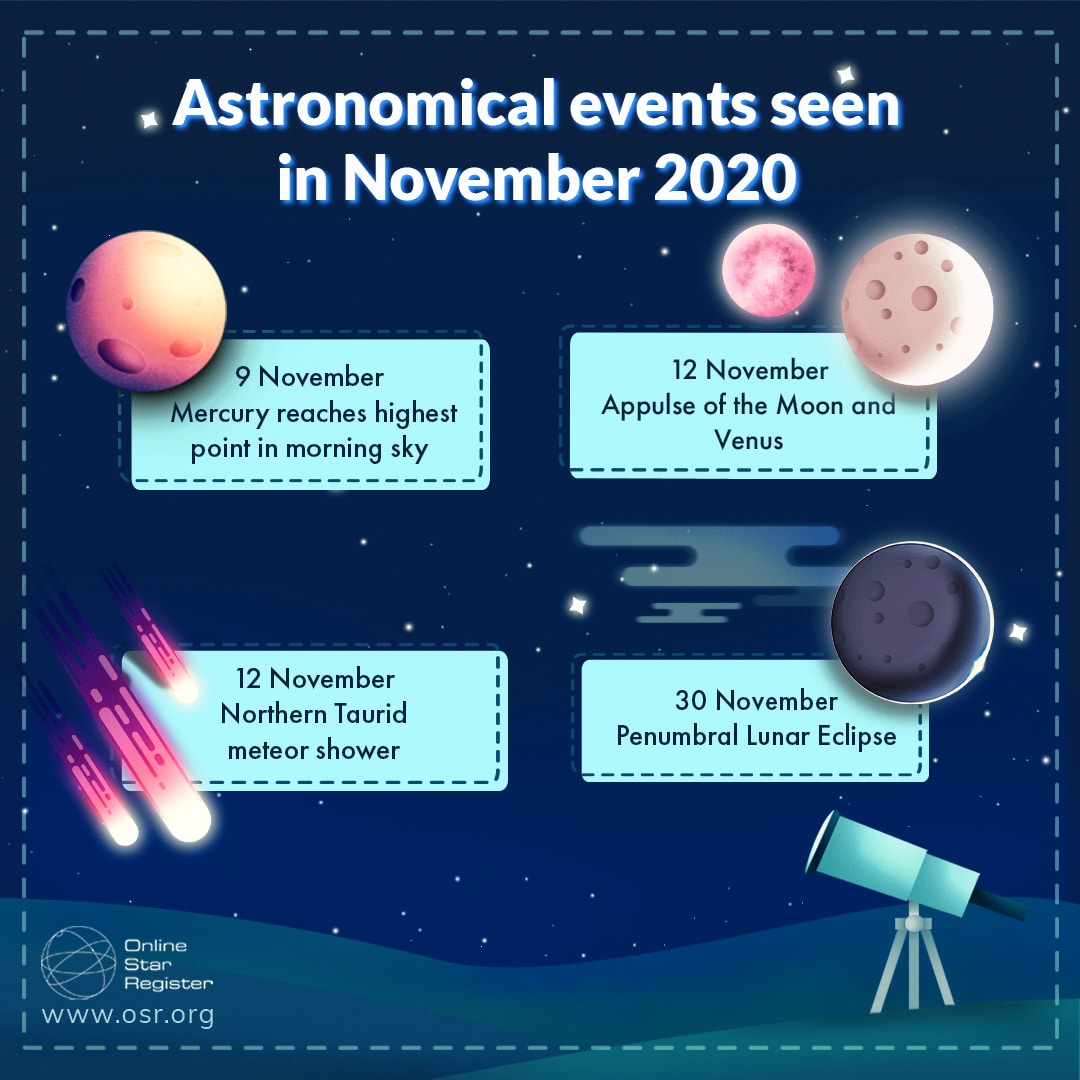The astronomical events of November 2020

November will be a month with some amazing astronomical events to discover! Come explore the astronomical events of November 2020 with us! Learn more about Mercury’s highest point in the morning sky, the appulse of the Moon and Venus, the Northern Taurid meteor shower and the Penumbral Lunar Eclipse!
Let us guide you through the astronomical events of November 2020. Just like last month, we have handpicked four mesmerizing astronomical events. While choosing these astronomical events we have done our best to pick some amazing ones which are visible with the naked eye! If you have binoculars or a telescope at your disposal, feel free to use them. Coincidentally, two of the astronomical events of November 2020 fall on the same day this year! Be sure to note down the dates of the events in your calendar.

Astronomical Event #1: Mercury at its highest point in the morning sky
The planet Mercury is the closest planet to the Sun. Additionally, Mercury is the smallest planet in our solar system. It is not known when exactly Mercury was first discovered, what we do know is that Mercury was first observed through a telescope by Galileo Galilei. The planet has been named Mercury by the Romans.
Mercury lies closer to the Sun than the Earth does. This causes Mercury to often get lost in the Sun’s glare. Therefore, Mercury is only observable for a few weeks when Mercury is at its highest point in the morning sky. This only happens each 3 to 4 months. The position of Mercury when it reaches its highest point will be: RA 13h53m00s -09°09′ dec -0.6 mag in the constellation Virgo. Want help with looking up these coordinates with your OSR Star Map? Watch the OSR Star Map Tutorial video.
On Monday the 9th of November, you will be able to see Mercury either in the east or in the west. When Mercury lies to the east, it rises and sets a short time after the Sun and is visible in early evening twilight. When it lies to the west of the Sun, it rises and sets a short time before the Sun and is visible shortly before sunrise. Make sure to not point a pair of binoculars or a telescope at Mercury when looking at it, since it will be close to the Sun.
Astronomical Event #2: Appulse of the Moon and Venus
An appulse is a technical term for a close approach of two astronomical objects. This November we will be able to see the appulse of the Moon and Venus in the night sky. This is a beautiful astronomical event to view since Venus is the brightest planet in our starry sky. Unlike Mercury – Venus can still be observed around midnight when it is at a great angular distance from the Sun. Because of this, we usually find Venus in the morning or evening sky, as an extremely bright “star”.
So how does an appulse work? Well, as the Moon and planets move along the ecliptic at different speeds, they pass each other from time to time. In some cases this is extremely rare such as with the conjunction of the planets Uranus and Neptune. However, conjunctions and appulses with the Moon are more common. The Moon passes a conjunction with every planet roughly once a month.
On Thursday the 12th of November, the Moon and Venus will make a close approach. You can find the Moon and Venus in the constellation Virgo. Virgo is among the richest areas of the sky to spot galaxies and distant night sky objects. Spica, located in the ear of wheat Virgo holds in her left hand, is the brightest star in the constellation. Need help finding the constellation Virgo? Use our OSR Star Finder App!
Astronomical Event #3: Northern Taurid meteor shower
The Taurid meteor shower is a meteor shower which actually has diffused into two seperate meteor showers over time. This is because of the gravitational deviation of planets and especially because of the planet Jupiter. We now have the Northern Taurids and the Southern Taurids. The Southern Taurids are active from the 10th of September to the 20th of November, while the Northern Taurids are active from the 20th of October to the 10th of December. Essentially, these two meteor showers are two cross sections of a single, wide, continuous stream in space.
The Northern Taurid meteor shower has originated from the asteroid 2004 TG10. The meteor shower is named after the radiant point, since it lies in the constellation Taurus. Because of its occurrence in late October and early November, the meteor shower is also called “Halloween fireballs”. At its peak, the Northern Taurid meteor shower is expected to produce a nominal rate of around 5 meteors per hour.
The Northern Taurid meteor shower will be producing its peak rate of meteors on the 12th of November. It will be visible around midnight and early morning, depending upon your exact location. The shower will peak close to the new moon, and so moonlight will present minimal interference. Therefore, it will be easier to find the meteors!
Astronomical Event #4: Penumbral Lunar Eclipse
Like other lunar eclipses, penumbral eclipses occur whenever the Earth passes between the Moon and Sun. Therefore, it obscures the Sun’s light and casts a shadow onto the Moon’s surface. In a penumbral eclipse the Moon passes through an outer region of the Earth’s shadow called the penumbra. This is the outer part of the Earth’s shadow, in which the Earth appears to cover part of the Sun’s disk, but not all of it.
The effect of a penumbral lunar eclipse is therefore only perceptible to those with very good vision. Only 82% of the Moon’s face will pass within the Earth’s penumbra at the moment of greatest eclipse, and so a reduction in the Moon’s brightness may be perceptible. Therefore, unlike other kinds of eclipses, a penumbral lunar eclipse is an extremely subtle events to observe. A lunar eclipse happens roughly once every six months, usually two weeks before or after a solar eclipse. The solar eclipse will be taking place on the 14th of December.
You will be able to see the penumbral lunar eclipse on Monday the 30th of November. Eclipses of the Moon are visible anywhere where the Moon is above the horizon at the time. Since the science behind lunar eclipses requires that the Moon is directly opposite the Sun in the sky, the Moon can be seen above the horizon anywhere where the Sun is beneath the horizon.
Enjoy exploring the night sky!
We hope to have given you enough reasons to go out exploring the night sky with the astronomical events of November 2020! From Mercury’s highest point in the sky, to the appulse of the Moon and Venus, the Northern Taurid meteor shower and the Penumbral Lunar Eclipse. The night sky of November is full of surprises!
Want to stay in the loop on the upcoming astronomical events?
